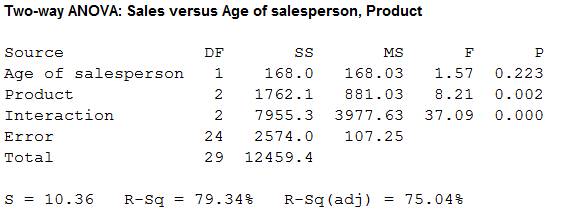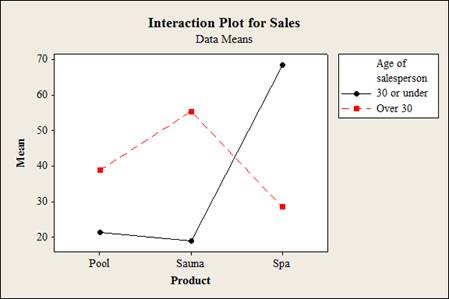
Concept explainers
a.
To state: The hypothesis.
a.
Answer to Problem 15E
The hypothesis for interaction is,
The hypothesis for age of salespersonis,
The hypothesis for product is,
Explanation of Solution
Given info:
The table shows age of the sales representative and type of item affect monthly sales.
Calculation:
The hypothesis for interaction is,
Null hypothesis:
Alternative hypothesis:
The hypothesis for age of salesperson is,
Null hypothesis:
Alternative hypothesis:
The hypothesis for productis,
Null hypothesis:
Alternative hypothesis:
b.
To find: The critical value for each F test.
b.
Answer to Problem 15E
The critical F-value of A is 4.26.
The critical F-value of B and
Explanation of Solution
Given info:
The level of significance is 0.05.
Calculation:
Consider factors A represent the type of paintand B represents the geographic location.
Here,
The formula to find the degrees of freedom for factor A is,
Thus, the degrees of freedom for factor A is1.
Here,
The formula to find the degrees of freedom for factor B is,
Thus, the degrees of freedom for factor B is3.
The formula to find the degrees of freedom for factor
Thus, the degrees of freedom for factor
The degrees of freedom for the within (error) factor
The degrees of freedom for the within (error) factor is 24.
Critical value:
Here A having 1 degrees of freedom and B and
For A:
The critical F-value of A is obtained using the Table H: The F-Distribution with the level of significance
Procedure:
- Locate 24 in the degrees of freedom, denominator row of the Table H.
- Obtain the value in the corresponding degrees of freedom, numerator column below 1.
That is,
Thus, the critical F-value of A is 4.26.
For B and
The critical F-value of B and
Procedure:
- Locate 24 in the degrees of freedom, denominator row of the Table H.
- Obtain the value in the corresponding degrees of freedom, numerator column below 2.
That is,
Thus, the critical F-value of B and
Decision criteria:
If
If
If
c.
To compute: The summary table.
To find: The test value.
c.
Answer to Problem 15E
The summary table is,

The test valuesare 1.57, 8.21 and 37.09.
Explanation of Solution
Calculation:
Software procedure:
Step-by-step procedure to obtain the test statistics and P-value using the MINITAB software:
- Choose Stat > ANOVA > Two-Way.
- In Response, enter the column of Sales.
- In Row Factor, enter the column of Ages of sales person.
- In Column Factor, enter the column of product.
- Click OK.
Output using the MINITAB software is given below:

From Minitab output, the test valuesare 1.57, 8.21 and 37.09.
d.
To make: The decision.
d.
Answer to Problem 15E
The null hypothesis is rejected for
Explanation of Solution
Conclusion:
From the result of part (c), the
Decision for
Here, the test value of
That is,
Thus, it can be concluding that, the null hypothesis for
Decision for
Here, the test value of
That is,
Thus, it can be concluding that, the null hypothesis for
Decision for
Here, the test value of
That is,
Thus, it can be concluding that, the null hypothesis for
e.
To explain: The results.
e.
Answer to Problem 15E
The result concludes that, there is an interception effect between the ages of salespeople and the type of products sold.
Explanation of Solution
Calculation:
From the results, it can be observed there is a significant between the ages of the sales people and the products they sell on the monthly sales.
Here, the integration effect is between the ages of the sales person and the type of product sold. So, the procedure for drawing the graph for the interaction plot is given below.
Minitab Procedure:
- Choose Stat > ANOVA >Interaction Plot.
- In Response, enter the column of Sales.
- In Factors, enter the column of Ages of sales person and product.
- Click OK.
Output using the MINITAB software is given below:

Interpretation:
From the graph, it can be observed that the lines cross. So, the interaction is disordinal interaction. Hence there is an interception effect between the ages of salespeople and the type of products sold.
Want to see more full solutions like this?
Chapter 12 Solutions
ELEMENTARY STATISTICS W/CONNECT >IP<
- Solve the following LP problem using the Extreme Point Theorem: Subject to: Maximize Z-6+4y 2+y≤8 2x + y ≤10 2,y20 Solve it using the graphical method. Guidelines for preparation for the teacher's questions: Understand the basics of Linear Programming (LP) 1. Know how to formulate an LP model. 2. Be able to identify decision variables, objective functions, and constraints. Be comfortable with graphical solutions 3. Know how to plot feasible regions and find extreme points. 4. Understand how constraints affect the solution space. Understand the Extreme Point Theorem 5. Know why solutions always occur at extreme points. 6. Be able to explain how optimization changes with different constraints. Think about real-world implications 7. Consider how removing or modifying constraints affects the solution. 8. Be prepared to explain why LP problems are used in business, economics, and operations research.arrow_forwardged the variance for group 1) Different groups of male stalk-eyed flies were raised on different diets: a high nutrient corn diet vs. a low nutrient cotton wool diet. Investigators wanted to see if diet quality influenced eye-stalk length. They obtained the following data: d Diet Sample Mean Eye-stalk Length Variance in Eye-stalk d size, n (mm) Length (mm²) Corn (group 1) 21 2.05 0.0558 Cotton (group 2) 24 1.54 0.0812 =205-1.54-05T a) Construct a 95% confidence interval for the difference in mean eye-stalk length between the two diets (e.g., use group 1 - group 2).arrow_forwardAn article in Business Week discussed the large spread between the federal funds rate and the average credit card rate. The table below is a frequency distribution of the credit card rate charged by the top 100 issuers. Credit Card Rates Credit Card Rate Frequency 18% -23% 19 17% -17.9% 16 16% -16.9% 31 15% -15.9% 26 14% -14.9% Copy Data 8 Step 1 of 2: Calculate the average credit card rate charged by the top 100 issuers based on the frequency distribution. Round your answer to two decimal places.arrow_forward
- Please could you check my answersarrow_forwardLet Y₁, Y2,, Yy be random variables from an Exponential distribution with unknown mean 0. Let Ô be the maximum likelihood estimates for 0. The probability density function of y; is given by P(Yi; 0) = 0, yi≥ 0. The maximum likelihood estimate is given as follows: Select one: = n Σ19 1 Σ19 n-1 Σ19: n² Σ1arrow_forwardPlease could you help me answer parts d and e. Thanksarrow_forward
- When fitting the model E[Y] = Bo+B1x1,i + B2x2; to a set of n = 25 observations, the following results were obtained using the general linear model notation: and 25 219 10232 551 XTX = 219 10232 3055 133899 133899 6725688, XTY 7361 337051 (XX)-- 0.1132 -0.0044 -0.00008 -0.0044 0.0027 -0.00004 -0.00008 -0.00004 0.00000129, Construct a multiple linear regression model Yin terms of the explanatory variables 1,i, x2,i- a) What is the value of the least squares estimate of the regression coefficient for 1,+? Give your answer correct to 3 decimal places. B1 b) Given that SSR = 5550, and SST=5784. Calculate the value of the MSg correct to 2 decimal places. c) What is the F statistics for this model correct to 2 decimal places?arrow_forwardCalculate the sample mean and sample variance for the following frequency distribution of heart rates for a sample of American adults. If necessary, round to one more decimal place than the largest number of decimal places given in the data. Heart Rates in Beats per Minute Class Frequency 51-58 5 59-66 8 67-74 9 75-82 7 83-90 8arrow_forwardcan someone solvearrow_forward
- QUAT6221wA1 Accessibility Mode Immersiv Q.1.2 Match the definition in column X with the correct term in column Y. Two marks will be awarded for each correct answer. (20) COLUMN X Q.1.2.1 COLUMN Y Condenses sample data into a few summary A. Statistics measures Q.1.2.2 The collection of all possible observations that exist for the random variable under study. B. Descriptive statistics Q.1.2.3 Describes a characteristic of a sample. C. Ordinal-scaled data Q.1.2.4 The actual values or outcomes are recorded on a random variable. D. Inferential statistics 0.1.2.5 Categorical data, where the categories have an implied ranking. E. Data Q.1.2.6 A set of mathematically based tools & techniques that transform raw data into F. Statistical modelling information to support effective decision- making. 45 Q Search 28 # 00 8 LO 1 f F10 Prise 11+arrow_forwardStudents - Term 1 - Def X W QUAT6221wA1.docx X C Chat - Learn with Chegg | Cheg X | + w:/r/sites/TertiaryStudents/_layouts/15/Doc.aspx?sourcedoc=%7B2759DFAB-EA5E-4526-9991-9087A973B894% QUAT6221wA1 Accessibility Mode பg Immer The following table indicates the unit prices (in Rands) and quantities of three consumer products to be held in a supermarket warehouse in Lenasia over the time period from April to July 2025. APRIL 2025 JULY 2025 PRODUCT Unit Price (po) Quantity (q0)) Unit Price (p₁) Quantity (q1) Mineral Water R23.70 403 R25.70 423 H&S Shampoo R77.00 922 R79.40 899 Toilet Paper R106.50 725 R104.70 730 The Independent Institute of Education (Pty) Ltd 2025 Q Search L W f Page 7 of 9arrow_forwardCOM WIth Chegg Cheg x + w:/r/sites/TertiaryStudents/_layouts/15/Doc.aspx?sourcedoc=%7B2759DFAB-EA5E-4526-9991-9087A973B894%. QUAT6221wA1 Accessibility Mode Immersi The following table indicates the unit prices (in Rands) and quantities of three meals sold every year by a small restaurant over the years 2023 and 2025. 2023 2025 MEAL Unit Price (po) Quantity (q0)) Unit Price (P₁) Quantity (q₁) Lasagne R125 1055 R145 1125 Pizza R110 2115 R130 2195 Pasta R95 1950 R120 2250 Q.2.1 Using 2023 as the base year, compute the individual price relatives in 2025 for (10) lasagne and pasta. Interpret each of your answers. 0.2.2 Using 2023 as the base year, compute the Laspeyres price index for all of the meals (8) for 2025. Interpret your answer. Q.2.3 Using 2023 as the base year, compute the Paasche price index for all of the meals (7) for 2025. Interpret your answer. Q Search L O W Larrow_forward
 Glencoe Algebra 1, Student Edition, 9780079039897...AlgebraISBN:9780079039897Author:CarterPublisher:McGraw Hill
Glencoe Algebra 1, Student Edition, 9780079039897...AlgebraISBN:9780079039897Author:CarterPublisher:McGraw Hill Big Ideas Math A Bridge To Success Algebra 1: Stu...AlgebraISBN:9781680331141Author:HOUGHTON MIFFLIN HARCOURTPublisher:Houghton Mifflin Harcourt
Big Ideas Math A Bridge To Success Algebra 1: Stu...AlgebraISBN:9781680331141Author:HOUGHTON MIFFLIN HARCOURTPublisher:Houghton Mifflin Harcourt

